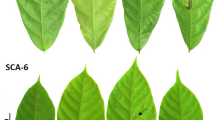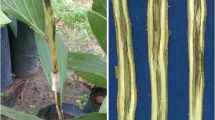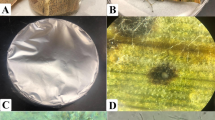Abstract
Five methods of stem inoculation of carnations with conidial suspensions ofFusarium oxysporum f.sp.dianthi were compared for uptake of the suspension, induction of phytoalexin accumulation and wilt development. Inoculation was performed by incision of the stem across droplets of inoculum placed on leaves, or by injection of droplets into the stem. With both methods, higher inoculum dosages led to higher wilting rates and higher phytoalexin concentrations. Injection was more effective than incision since a lower inoculum dosage was required to obtain the same phytoalexin levels. Injection therefore appears the most promising technique for the development of routine screening methods for resistance based on phytoalexin accumulation.
Samenvatting
Vijf methoden om anjers via de stengel te inoculeren met een sporensuspensie vanF. oxysporum f.sp.dianthi werden vergeleken wat betreft de opname van de suspensie, de accumulatie van fytoalexinen en het ziekteverloop. Inoculatie vond plaats door de stengel aan te snijden dwars door een druppel inoculum die op een blad was gelegd, of door druppeltjes inoculum te injecteren. Bij beide methoden leidden hogere doses inoculum tot heviger ziektesymptomen en accumulatie van grotere hoeveelheden fytoalexinen. Injectie van inoculum was effectiever dan aansnijden, daar er minder inoculum nodig was voor eenzelfde resultaat. Injectie biedt daarom meer perspectief voor de ontwikkeling van routinematige resistentietoetsen op basis van de accumulatie van fytoalexinen.
Similar content being viewed by others
References
Baayen, R.P. & Elgersma D.M., 1985. Colonization and histopathology of susceptible and resistant carnation cultivars infected withFusarium oxysporum f.sp.dianthi. Netherlands Journal of Plant Pathology 91: 119–135.
Baayen, R.P. & Niemann, G.J., 1989. Correlations between accumulation of dianthramides, dianthalexin and unknown compounds, and partial resistance toFusarium oxysporum f.sp.dianthi in eleven carnation cultivars. Journal of Phytopathology 126: 281–292.
Niemann, G.J. & Baayen, R.P., 1988a. Involvement of phenol metabolism in resistance ofDianthus caryophyllus toFusarium oxysporum f.sp.dianthi. Netherlands Journal of Plant Pathology 94: 289–301.
Niemann, G.J. & Baayen, R.P., 1988b. Chemische verschillen tussen vatbare en resistente anjercultivars. Vakblad voor de Bloemisterij 15 (1988): 38–39.
Sokal, R.R. & Rohlf, F.J., 169. Biometry. The principles and practice of statistics in biological research. W.H. Freeman & Company, San Francisco, 776 pp.
Author information
Authors and Affiliations
Rights and permissions
About this article
Cite this article
Baayen, R.P., Schrama, R.M. Comparison of five stem inoculation methods with respect to phytoalexin accumulation and Fusarium wilt development in carnation. Netherlands Journal of Plant Pathology 96, 315–320 (1990). https://doi.org/10.1007/BF01998779
Accepted:
Issue Date:
DOI: https://doi.org/10.1007/BF01998779




